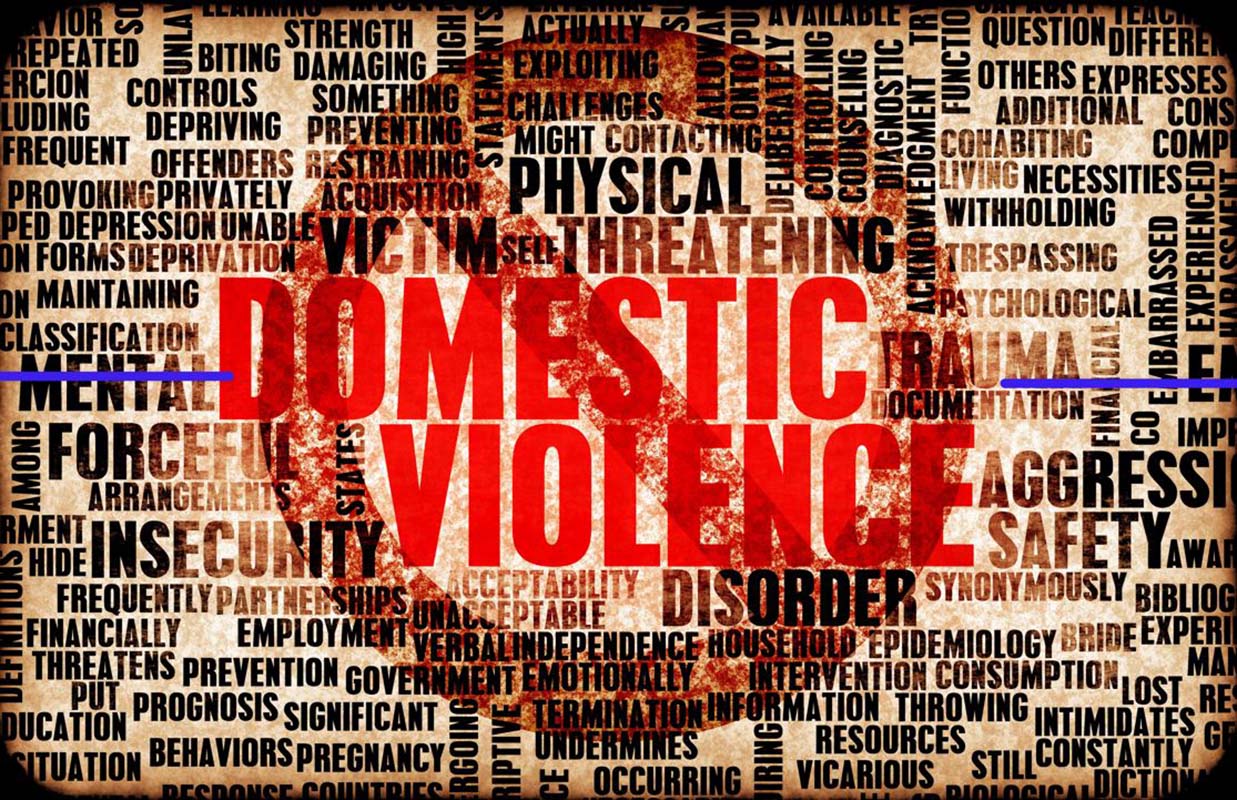In this article, we will discuss the legal domestic violence definition so you can understand what is considered domestic violence in the eyes of the law. By knowing the legal domestic violence definition, it can help you to seek domestic violence support services and understand your legal rights and options.
What Is the Legal Definition of Domestic Violence?
The legal definition of domestic violence is threats of abuse or abuse between people in an intimate relationship. The definition of an intimate relationship includes people who are related, dating or used to date, who have a child together, who live together or used to live together, married partners, or domestic partners.
The legal definition of domestic violence considers the following behaviors to be abuse:
- Sexual assault
- Threatening harm or promising harm
- Harassment
- Stalking
- Destroying personal property
- Disturbing the peace
- Physical abuse
- Verbal abuse
- Emotional abuse
- Psychological abuse
- Financial abuse
- Reckless physical harm
Physical abuse is not just hitting, punching, or kicking. It includes pulling hair, scaring someone, pushing or shoving, following someone, throwing things, preventing free movement.
Anyone Can Be a Victim of Domestic Violence
The legal definition of domestic violence recognizes that anyone can be a victim of domestic violence. It does not exclude certain genders, ages, sexual orientations, classes, races, or faiths. Children and step-children can be victims of domestic violence, as can husbands or wives.
If you believe you are a victim of domestic violence, continue reading.
Domestic Violence Definition: Examples of Domestic Abuse
Domestic violence usually escalates over time as the abuser seeks to gain more control over their victim. This is why the legal definition of domestic violence equally recognizes both a physically violent display and a pattern of abusive behavior.
Are the following signs of domestic abuse present in your intimate relationships?
- Belittling or embarrassing you in front of friends and family
- Forbidding you from making decisions on your own or making you feel like you are too stupid to make decisions on your own
- Intimidates you in order to get their way
- Minimizes or makes fun of your accomplishments
- Excuses their abuse by blaming alcohol, drugs, pain, or stress
- Blames you for the abuse because of how you act, look, etc.
- Checks in multiple times when you or they are not home or makes you check in. Asks to send videos or photographs as “proof” you are where you say you are
- Requires you to have location services shared with them so they can see where you are at all times
- They are rough with you, shove you out of the way, grabs you, pushes you. This may escalate to hitting you, pinching you, or kicking you
- Stops you from doing things you want to, like seeing friends and family or participating in hobbies
- Requires you to ask permission before doing things
- Forbids you from seeing certain people, like certain family members or friends, or people of the sex you are attracted to
- Calls you degrading names when you do things wrong
- Leaves you stranded somewhere to teach you a lesson
- Physically prevents you from leaving by locking you in places, pinning you down, or any other method
- Tells you regularly that you are nothing without them or that without them, you would be homeless/in another bad position
- Pressures you into sexual acts before you are ready or pressures you into sexual acts that you don’t want to do (either ever or just in that moment)
Often victims of domestic violence or domestic abuse will feel like they are walking on eggshells. They will try to do everything perfectly to try and avoid an “eruption” from their abuser. When they do or say something wrong, they are scared of the reaction from their abuser. They may also become scared when they see their abuser drinking, using drugs, or in a bad mood. Because their abuser often blames them and their shortcoming for the abuse, they believe that becoming the perfect partner or child is the key to stopping the abuse. Someone experiencing domestic violence or domestic abuse may also be afraid to leave the situation. They may be scared that their abuser would kill them or harm themselves. The abuser may tell them so on a regular basis.
If any of these things resonate with you, you are experiencing domestic violence. It can be difficult to ask for help because you cannot see a way out. Nobody deserves to be abused, and there are people out there who can help you. The abuse is not your fault, and leaving will not put your visa in jeopardy. Abusers will often seek to isolate their victims, so you may not have a community available to you, but there are domestic violence support services that can help you leave and provide you with shelter and essential services. They can help you with immigration services and even provide assistance in your first language.
Power and Control: Types of Abuse Included In the Domestic Violence Definition
Most people know that physical abuse and sexual assault fall under the domestic violence definition. The abuse victim is more likely to recognize that they are being abused, and others may notice the signs of abuse. These types of domestic violence usually go hand in hand with other types of domestic violence, like emotional abuse or psychological abuse. The root cause of domestic violence boils down to control and the power balance. The abuser seeks to hold their power over their victim in order to control them. The power may be fear of violence, feeling worthless or unloveable, or their victim may have to ask them for money. These other types of domestic violence are harder to identify from an outside perspective, and the victim may not even realize that they are experiencing abuse.
Here are some of the other types of abuse included in the domestic violence definition.
Psychological Abuse
Psychological abuse is inducing fear in the abuse victim in order to control them. This may be threatening to harm them, their children, their property, or pets. The abuser will also isolate their victim from friends and family or anyone else that may help the victim. This can be done subtly, through criticizing their friends and family and implying they do not care about the victim or that they are a bad influence. It may also be through monopolizing the victim’s time and getting them to cancel plans last minute in order to get their friends and family to not want to make plans. The abuser may also play mind games in order to get the victim to doubt their own sanity. They may use gaslighting to make the victim doubt their position or use love bombing to convince the victim that the abuser loves them and is a good person.
Emotional Abuse
Emotional abuse is one of the most common types of abuse and one of the most difficult to recognize. It can start really subtly through criticizing the person’s actions and undermining their self-worth. The abuser may embarrass their victim in front of family and friends or call them names when they make a mistake. These are some of the behaviors of emotional abuse:
-
- Requires you to ask permission to go out, see people, work, etc.
- Humiliates you in front of other people
- Belittles you or makes you feel worthless
- Criticizes everything you do
- Withholds affection in order to punish you for something
- Monitors what you do and who you see
- Requires regular check ins when they are not with you
- Uses location services to track your movements
- Is jealous or possessive and restricts your interactions with close friends or members of the sex you are attracted to
- Pits themselves against your family or friends and frames you spending time with family or friends as “choosing” them over your abuser
- Tries to interfere with your job in order to get you fired or hamper your career
- Encourages you not to work in order to be the sole earner
- Controls the money and makes you ask for money instead of providing an allowance or a join account
- Threatens to harm you, your pets, your children, or your family
Financial Abuse
Financial abuse is strict control over the finances to ensure the victim has to ask for money and does not have the funds to leave the relationship. The victim will feel like they have to stay because they have nothing and will be homeless if they leave. Financial abuse often starts with encouraging the victim to quit their job or otherwise causing the victim to lose their job so they become financially dependent on the abuser. Once the victim has no money of their own, the abuser will control the financial resources, requiring the victim to ask for money to buy groceries and may even ask for receipts or proof of purchase.
Stalking
Stalking covers a range of harassing or threatening behaviors such as following the victim, unwelcome gifts or letter, frequent telephone calls, or showing up at the victim’s work, home, or places they regularly go. Stalking is considered a serious crime as it usually escalates into breaking and entering, kidnap, assault, sexual assault, or even murder.
Sexual Abuse
Sexual abuse includes forcing or coercing a partner into unwanted sexual conduct. The following conduct usually happens in a sexually abusive relationship:
-
- Requiring the victim to dress in a way that the victim considers overtly sexual and is uncomfortable with
- Insults the victim through names that insult the victim’s sexuality
- Extreme jealousy and accusations of cheating or teasing other people
- Ignores your thoughts or feelings about sexual contact or during sex
- Non-consensual sexual contact (rape)
- Coerced sexual contact or manipulating the victim into sexual contact through threats of violence or threats of withholding something from the victim
- Demands sex without taking into account your physical or emotional state, such as if you are exhausted, sick, upset, too soon after childbirth, or after physically abusing you
- Coerces you into sexual contact with other people or forces you into sexual contact with other people
- Pins you down during sex
- Uses objects or weapons to hurt you during sex
Physical Abuse
Physical abuse is the most well-known domestic violence definition and encompasses all acts and threats of physical violence. Threatening or doing any of the following are indicators of physical abuse:
-
- Is violent when angry such as smashing objects, throwing things, punching walls or doors.
- Drives recklessly in order to scare you
- Threatens you with a weapon or hurts you with a weapon
- Choking
- Kicking
- Shoving or pushing
- Biting
- Hitting
- Using physical violence during sex or in order to force you to have sex
- Trapping you in your home or in a room either physically preventing you from leaving or locking you in
- Hurting your children or pets
- Forcing you to leave your home
- Stops you from calling medical assistance or law enforcement
If you are experiencing any of the above types of abuse, it is not your fault. Many people, unfortunately, experience abuse at the hands of those they love. There is a way out, no matter what your situation is. You have value, and there are people in the world who care about you and want to help you. You will not be deported, nor will escaping abusive situations negatively impact your immigration status.
Domestic Violence Definitions: Restraining Orders
What is a restraining order? A restraining order is a court order that restricts the proximity of your abuser. It can prevent them from contacting you, visiting your home or workplace, and from being near you. If the abuser violates the restraining order, they may receive criminal charges.
You can apply for a domestic violence restraining order against someone close to you if they are abusing you or threatening abuse. The abuser may be a relative, a spouse or domestic partner, an ex-partner, someone you are dating or living with as a friend or partner. It can also be the partner of your child or someone you used to live with or date.
You can also apply for a domestic violence restraining order on behalf of your child if they are under the age of 12.
Other Types of Restraining Orders
If you do not meet the criteria of a domestic violence restraining order, you may apply for one of the following to protect yourself.
-
- Elder abuse restraining order
- Dependent adult abuse restraining order
- Civil harassment restraining order
- Workplace violence restraining order
If you are experiencing domestic violence or some kind of abuse and harassment, then speak to an attorney. Most lawyers offer free consultations and can help you with resources and filing a restraining order. If you are a member of a reservation or tribal community, then your tribe will be able to provide you with a protective order and resources.
A Domestic Violence Restraining Order Can…
-
- Force your abuser to move out of your house
- Keep your abuser away from your work, home, and your children’s schools
- Transfer financial accounts or cell phone accounts into the name of the abused person
- Force your abuser to complete therapy or a domestic violence intervention program
- Keep your abuser away from you, your immediate family, and those who live with you
- Force your abuser to pay child support and spousal support
- Keep your abuser away from your pets
- Force your abuser to return named property
- Prevent your abuser from carrying a gun
- Make your abuser follow visitation and custody orders
- Prevent your abuser from making changes to joint assets or insurance policies
A Domestic Violence Restraining Order Cannot…
-
- Dissolve your domestic partnership or marriage. You will need to file for legal separation or divorce in order to do so.
- Establish paternity of your child. You will need to file an agreement and judgement of parentage.
Domestic Violence Restraining Order Process
In order to obtain a domestic violence restraining order, the domestic violence victim must fill out forms that request certain measures and the reasons for those measures. A lawyer who specializes in domestic violence cases will be able to help with those forms. There is no filing fee for a domestic violence restraining order.
The process for domestic violence restraining orders is very quick; usually, the victim will receive a response by the next business day. If they believe there is a reason for a restraining order, they will issue a temporary restraining order that will remain in effect until the court date. The temporary restraining order will set clear restrictions.
Once the temporary restraining order is granted, it must be served to the abuser. Before the court hearing, the abuser will have a chance to answer the restraining order request by filing a formal response. There is a temporary restraining order in place, so they must not attempt to contact the people protected by the restraining order.
At the court hearing, both sides will be able to present evidence to support their version of events. The judge will listen to both parties and make a decision to either end the domestic violence restraining order or issue a permanent domestic violence restraining order. A permanent domestic violence restraining order can last for up to 5 years and may contain additional orders than the temporary one. If the parties have children together, then custody and visitation rights to the children may be ordered. If the person protected by the restraining order does not show for the hearing, the case will be dismissed, and the restraining order will be cancelled. If the person restrained by the restraining order does not show, then the judge will make a decision based on the evidence the protected person presents.
Once the court issues the domestic violence restraining order, it is entered into CLETS, which is a statewide database that all law enforcement officers can access. Restraining orders still apply even if you move out of the state it was issued in, and it will be enforced by other states’ law enforcement officers.
The person with a restraining order will have to move out of their own home if they live with the person who filed the restraining order. They will also have to stick to a visitation schedule approved by the court or may need to completely cut contact with their children. They will need to turn in any firearms and will not be able to buy a new one while the restraining order is valid. In some circumstances, the restraining order may affect their immigration status.
The consequences of violating a restraining order are fines, jail time, or both.
Types of Domestic Violence Restraining Orders
There are a number of domestic violence restraining orders that may be issued, depending on the circumstances.
-
- Emergency Protective Order– An emergency restraining order can be requested by law enforcement officers if they believe a domestic violence victim to be in immediate danger. The law enforcement officer can call a judge 24/7 to request this type of domestic violence restraining order. It goes into immediate effect and lasts 7 days to allow the victim time to apply for a temporary restraining order.
- Temporary Restraining Order – A judge will grant a temporary restraining order when they set a trial date for a permanent restraining order hearing. The domestic violence victim needs to fill out forms detailing the reason they are requesting a restraining order and what they wish to limit with the domestic violence restraining order. The temporary restraining order will last until the court hearing.
- Permanent Restraining Order – At the court hearing, the judge will decide if they want to issue a permanent domestic violence restraining order. They may set additional stipulations to restrict certain behaviors or set a custody agreement if children are involved. The length of a permanent domestic violence restraining order is up to 5 years, after which the domestic violence victim can request a new one be issued.
- Stay Away Order – If the abuser is facing criminal charges for domestic violence, the criminal court may issue a criminal protective order to protect the domestic violence victim. This protective order will last until the criminal case has been resolved. If the abuser is found guilty of domestic violence, then the judge may rule that the stay away order lasts for up to 3 years after the verdict has been reached.
- Emergency Protective Order– An emergency restraining order can be requested by law enforcement officers if they believe a domestic violence victim to be in immediate danger. The law enforcement officer can call a judge 24/7 to request this type of domestic violence restraining order. It goes into immediate effect and lasts 7 days to allow the victim time to apply for a temporary restraining order.
Seeking Help For Domestic Violence
If you are experiencing domestic violence, know you are not alone. There are many services and resources available to you. They can help you with shelter, finances, and legal advice if you need it.
You can file for a domestic violence restraining order without the help of a lawyer, but we recommend seeking the counsel of a lawyer or at least some sort of legal advice. The process is complex, and you may not be aware of the level of protection you can request. The attorney will help you to request the protection you need to protect yourself, your children, and any other family from domestic violence.
If you cannot afford an attorney, many domestic violence shelters or legal aid agencies can help you to file a domestic violence restraining order for free or a subsidized cost. Look for what help is available locally before you try to fill out the forms by yourself.





